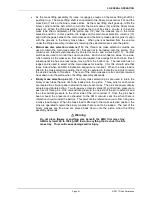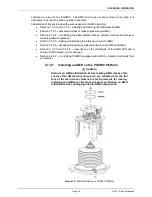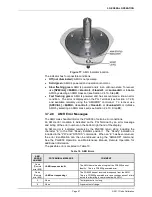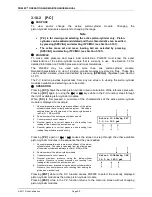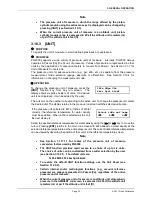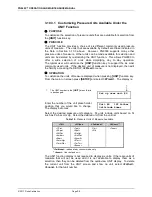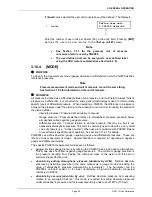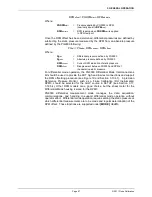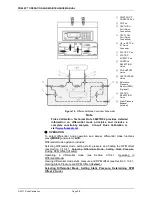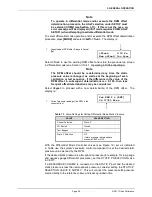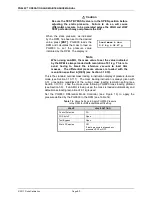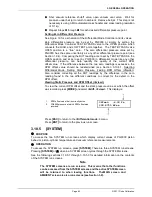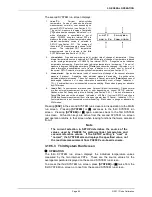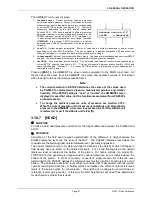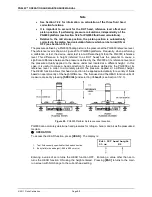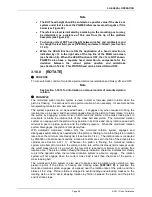
Page 55
© 2011 Fluke Calibration
If
<4user>
was selected, the user unit conversion must be defined. The display is:
1.
Entry field.
Define user unit:
1.000000 Units/Pa
Enter the number of user units per Pascal [Pa] in the entry field. Pressing
[ENT]
def ines the user unit and returns to the
<Set up unit #>
screen.
Note
•
See Section 7.1.1 for the pressure unit of measure
conversion factors used by PG9000.
•
The user defined unit can be assigned a user defined label
using the UDU remote command (see Section 4.3.4).
3.10.4 [MODE]
PURPOSE
To specify the measurement mode (gauge, absolute or differential) in which PG9000 defines
reference pressures.
Note
Pressure measurement mode and unit of measure are not the same thing.
See Section 3.10.3 for information on the unit of measure.
PRINCIPLE
All pressure is defined as a differential between two pressures, and it will help to always think of
pressure as a differential. For convenience, some general terminology is used to communicate
specific types of differential pressure. When operating a PG9000, the difference in pressure is
between the pressure under the piston and the pressure (or vacuum) surrounding the outside of
the piston-cylinder.
Absolute pressure
= Pressure defined relative to vacuum
Gauge pressure
= Pressure defined relative to atmospheric pressure, pressure below
atmosphere called
negative gauge pressure
.
Differential pressure
= defined relative to another pressure that may be, but is not
necessarily atmospheric pressure. This term is commonly used to describe a very small
value of pressure (e.g. ”inches of water”). When used in conjunction with PG9000 it takes
on an extremely specific mode of operation. See section 3.11.4.1 for details.
PG9000s can define absolute, gauge, negative gauge and differential pressures. These are
referred to as measurement
modes
. Special hardware is required for operating in negative
gauge and differential modes.
The specific PG9000 measurement modes are as follows:
•
gauge
: Defines gauge pressure by leaving the PG9000 mass load open to atmosphere.
This mode does not allow negative gauge pressures. The minimum gauge pressure is
the pressure resulting from loading the combined mass of the piston and the bell on
piston-cylinder effective area.
•
absolute by adding atmospheric pressure (absolute by ATM)
: Defines absolute
pressure by defining a pressure in the same manner as in
gauge mode
and adding the
value of atmospheric pressure measured by a barometer. The barometer can be
PG9000’s on-board sensor, or for lower uncertainty, a high-end barometer connected
remotely via RS232.
•
absolute by vacuum (absolute by vac)
: Defines absolute pressure by measuring
relative to an evacuated bell jar. This mode is required for setting absolute pressures
under atmospheric pressure and for lowest uncertainty under about 1 MPa (150 psi).
Summary of Contents for PG9000 Series
Page 10: ...PG9602 OPERATION AND MAINTENANCE MANUAL 2011 Fluke Calibration Page X Notes...
Page 128: ...PG9602 OPERATION AND MAINTENANCE MANUAL 2011 Fluke Calibration Page 118 Notes...
Page 164: ...PG9602 OPERATION AND MAINTENANCE MANUAL 2011 Fluke Calibration Page 154 Notes...
Page 188: ...PG9602 OPERATION AND MAINTENANCE MANUAL 2011 Fluke Calibration Page 178 Notes...
Page 192: ...PG9602 OPERATION AND MAINTENANCE MANUAL 2011 Fluke Calibration Page 182 Notes...

